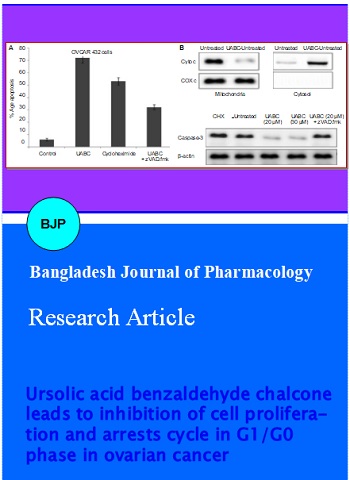Ursolic acid benzaldehyde chalcone leads to inhibition of cell proliferation and arrests cycle in G1/G0 phase in ovarian cancer
DOI:
https://doi.org/10.3329/bjp.v10i2.21753Keywords:
Benzaldehyde chalcone, Cell cycle arrest, Cell proliferation, G1/G0 phase, Ovarian cancer, Ursolic acidAbstract
In the present study, the effect of ursolic acid benzaldehyde chalcone (UABC) on ovarian carcinoma cells was studied. The results revealed that ovarian carcinoma cells on UABC treatment increased Sub-G1 cell population, increased rate of cell apoptosis and morphological changes in mitochondrial membrane. In OVCAR 432 cells treatment with UABC increased the Sub-G1 cell population to 72.3% and growth inhibition rate of >72%. Treatment with 20 µM of UABC for 48 hours, led to an induction of apoptosis in 67.2% and induced morphological changes in OVCAR 432 cells. The Western blot results showed high concentration of cytochrome c in the cell cytosol after 48 hours of UABC treatment. Treatment of RMS-13 cells with UABC resulted in inhibition of GLI1, GLI2, PTCH1, and IGF2 genes. In addition, we found a significant reduction in hedgehog activity of RMS-13 cells after UABC treatment by means of a hedgehog-responsive reporter assay. Therefore, UABC can be a promising agent for the treatment of ovarian carcinoma.
Downloads
488
441 Read
330

Published
How to Cite
Issue
Section
License
Authors who publish with this journal agree to the following terms:
- Authors retain copyright and grant the journal right of first publication with the work simultaneously licensed under a Creative Commons Attribution License that allows others to share the work with an acknowledgement of the work's authorship and initial publication in this journal.
- Authors are able to enter into separate, additional contractual arrangements for the non-exclusive distribution of the journal's published version of the work (e.g., post it to an institutional repository or publish it in a book), with an acknowledgement of its initial publication in this journal.
- Authors are permitted and encouraged to post their work online (e.g., in institutional repositories or on their website) prior to and during the submission process, as it can lead to productive exchanges, as well as earlier and greater citation of published work (See The Effect of Open Access).
